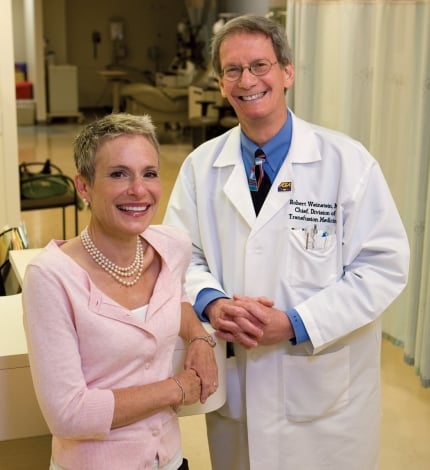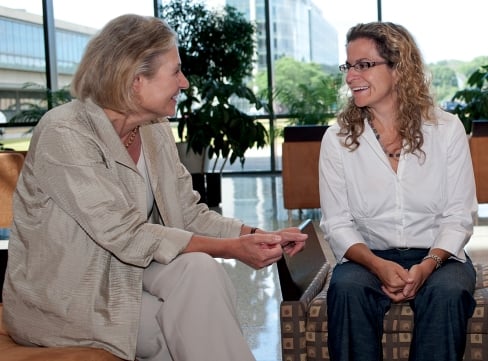A new way of teaching medicine begins with School of Medicine’s entering class

When Nancy Skehan, MD ’06, started at UMass Medical School in 2002, the structure of the curriculum was not unlike what students had experienced 30 years before, when the School of Medicine first opened: two years of basic science courses, where she acquired important foundational knowledge in subjects such as anatomy, physiology and microbiology, followed by two years of clinical rotations, where she put that basic science knowledge to use while serving as an active member of a health care team.
“In our first two years, we were tested on our ability to memorize and regurgitate information presented in a lecture,” said Dr. Skehan, who is finishing up as chief resident of internal medicine at UMass Memorial Medical Center. “It was good information, but at the time, I had no context for how I would be using it. And when the clinical years came around, I was racking my brains for the basic science information I had learned in my first two years of school.”
The complaint is common among medical students, who often struggle through the first two theoretical years in classrooms while eagerly awaiting the hands-on learning in the clinic. In fact, despite significant advances in what is taught, how students are taught at most U.S. medical schools can be traced back to the Flexner Report of 1910, which is credited with reforming medical education in the United States.
At UMass Medical School, all that is changing. When first-year students arrive on campus this August, they will be taught the practice of medicine in a new way. They will experience a fundamental change in the way courses are constructed, with basic science and clinical practice woven throughout all four years. But even more significantly, they will be expected to learn differently—both on their own and from faculty mentors and fellow students. They will be taught using nontraditional methods to take advantage of advances in technology. And they will be asked to master learning methods that will prepare them to be lifelong learners.
“Students will be in the clinic sooner, working in partnership with the basic sciences. They will focus more on the ability to learn and less on the ability to memorize,” said Michele P. Pugnaire, MD, senior associate dean for educational affairs and professor of family medicine & community health. “Learning on their own and learning in groups is the way they will be learning throughout their professional lives.”

An intricate group effort
The significance of this change cannot be overstated. The new Learner-Centered Integrated Curriculum (LInC) has involved years of study and thousands of hours of discussion and planning by more than 400 members of the UMMS and UMass Memorial community. Finally seeing the hard work come to life in August will be a milestone for the many individuals involved.
“It is beyond exciting,” said Melissa Fischer, MD, MEd, associate dean for undergraduate education, associate professor of medicine and chair of the LInC trustees, a group of UMMS faculty, staff, alumni and students providing overall direction and guidance for the redesign. “I am seeing layer upon layer of enthusiasm from all parts of the school.”
Like transplanting a giant tree, moving the curriculum in a different direction is a formidable undertaking, especially since the roots are more than 100 years deep. The genesis of the redesign dates back to 2003, when the School of Medicine defined six interrelated competencies that all graduates are expected to acquire: physician as professional, scientist, communicator, clinical problem solver, patient and community advocate, and person.
Once these competencies were established, the limitations of the traditional curriculum structure were exposed, according to Dr. Pugnaire. Representatives from all parts of the School of Medicine community, including current students and alumni, were recruited to start a curriculum redesign from the ground up. An intricate system of steering committees, advisory and consulting groups and design teams was formed, tapping every part of the school and involving hundreds of participants.
Many volunteers relished the idea that they would be making a difference in the way future medical students are prepared for the profession. “It’s a unique way to give back to the school,” said Laura Spring, a rising fourth-year student who is a LInC trustee. Despite the fact that she won’t experience the new curriculum herself, she said, “We are in a good position to give feedback and contribute.”
“As a recent graduate and current resident, I could recognize the shortcomings and redundancies of the existing structure,” said Skehan, who is also a LInC trustee. “It was a great opportunity to start from scratch.”

A new approach to teaching
A key element in LInC is the integration of basic science and clinical education into entirely new courses that focus on broader organ systems. Most new courses are being piloted by co-leaders from both worlds, all of whom were nominated by their department chairs.
For example, Leslie J. Berg, PhD, professor of pathology, and Robert Weinstein, MD, professor of medicine & pathology, had little professional interaction until recently when the two were named co-leaders of a new course called “Host Defense and Blood.”
Dr. Berg has taught courses on immunology and immuno-pathology for so long that she can create a lesson plan in her head. But she’s never ordered a test on a patient to diagnose an immunological disorder. Dr. Weinstein, chief of transfusion medicine at UMass Memorial, is comfortable teaching students the questions to ask a patient presenting with certain symptoms, but he has comparatively little experience in the classroom. The two have combined their expertise to create a new course that focuses on the interaction between the blood and immune systems, and encourages problem solving using real cases of hematologic and immune disorders.
Throughout the course, they are planning to tap other expert faculty to paint a comprehensive picture of the blood, immune and inflammatory systems, including learning about drugs related to the systems, a subject that in the past would have been covered during a broader pharmacology class. Likewise, they will focus on blood cancers such as leukemia, which would have been covered in a class on cancer in the previous curriculum.
“Before, courses used to be very autonomous. I never worried about what someone taught in infectious diseases, even though I was teaching immunology,” said Berg. “Now, all the course directors can see the topics covered in every other course and see where things might overlap. It’s a real exchange of information.”
“I might have had three different lectures on diabetes from three different points of view,” said Skehan on her educational experience. “The information was always in silos. The new curriculum lays it all out and you begin to see it in a more cohesive fashion.”
Added to the mix is the requirement that students receive information in creative and non-traditional ways—through online learning, case studies and other innovative methods. All incoming students will be required to have laptops to facilitate this new model.
“Actual lecture time is being decreased by 25 percent,” said Weinstein. “But there is still information that needs to be exchanged, and we have to find nontraditional ways to do that. The whole thing is a creative exercise. We are trying to do something new here.”
“It’s really great to see the excitement from the faculty who are finding new ways of teaching a subject,” said Diana Robillard, a rising fourth-year student and LInC trustee.
“Faculty who have never taught first-year students are now playing a very important role,” agreed fellow student Spring. “They bring a lot of interesting ideas to the table about the way students are taught.”
Ultimately, we hope to train better doctors
who can work within frameworks of changing medical knowledge and health care systems while remaining patient-centered.
Learning through communities
The change in course structure is just one part of the LInC model. Another significant component—and perhaps the most visible—is the creation of learning communities. All entering first-year students will be assigned to one of five “houses,” each with regionally significant names: Burncoat, Kelly, Tatnuck, Quinsigamond and Blackstone. Each house will include 100 students—four 25-student cohorts from all four class years. These social and academic homes will be overseen by faculty mentors, four per house, who will act as advisors, teachers and career development coaches. Learning communities will also allow more inter-class interaction, an important element missing from the traditional structure, where students in the first two years rarely crossed paths with students already in their clinical years.
“It’s about a transfer of knowledge. Students in upper classes can teach what they have learned through experience. Newer students can talk about the latest teaching methods or information they gathered from evolving technology,” said Pugnaire. “They will learn from each other because when they are out in the real world, that’s how they will continue to learn.”
The learning communities, which actually began informally last year thanks to a grass-roots effort led by current students, have dedicated space in the Medical School building at the moment. But when the Albert Sherman Center opens in 2012, the five houses will occupy two floors, with office and meeting rooms across from the standardized patient and simulation centers. This concept of home will become even more important as class time is reduced, and along with it, a significant portion of the student interaction that happens while hanging out in the lecture halls.
“The Sherman Center will be the hub, the heart and soul of the medical school community,” said Pugnaire. “Students will always have a place to go.”
A measure of success
While there will be satisfaction surveys given to students and residents, evaluations and data collected from residency directors and hospital officials to judge the preparedness of future School of Medicine alumni, as well as faculty feedback as the curriculum is fully implemented over the next four years, the true measure of the success of LInC will be less tangible.
“Ultimately, we hope to train better doctors who can work within frameworks of changing medical knowledge and health care systems while remaining patient-centered,” said Dr. Fischer. “We are focusing on competencies and on the skills that will allow our graduates to continue to build on what they learn here.”
“The most important thing we can teach these medical students is how to learn on their own,” agreed Weinstein. “Everything we teach has a half-life of relevancy. We hope that we are planting seeds to produce a crop of new doctors.”
“The curriculum is going to be more modern and relevant,” said Skehan. “Medical knowledge is exploding. It’s not feasible for medical schools to tread water. In a way, this had to happen.”